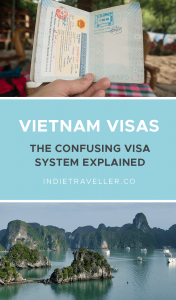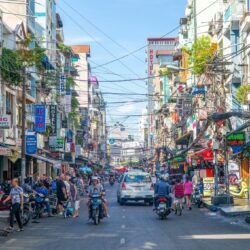Luckily, in 2023, things have changed for the better! Rarely has it been so satisfying to me to hit ‘delete’ on an entire blog post and replace it with a much shorter text. Travellers can rejoice in the old visa system in Vietnam finally being a thing of the past.
Let me explain what’s changed and how you can most easily get your valid entry visa for Vietnam.
Option 1: e-Visa
As of August 2023, you can enter Vietnam on an e-visa with a validity of 90 days. Travellers of any nationality can apply for e-visa.
With an e-visa you can:
- Apply directly online on the Vietnamese government website
- Stay in Vietnam for up to 90 days
- Enter Vietnam multiple times using any airport or overland border
You can apply for an e-visa here. (Be sure to switch the site to English in the top menu.)
The government fee is $25 for a single entry and $50 for a multiple-entry visa. Be sure to get the latter option if you plan to, say, make a side trip to Laos or Cambodia and then circle back to Vietnam and continue your trip there.
There are still some agencies that can help you with traditional visa requests, but this won’t be necessary for an e-visa. You can ignore outdated blogs that may still point you to these visa agencies.
You have to submit an application online, which then gets approved within a couple of working days. Once approved, you can head to Vietnam and show your e-visa to enter the country.
Option 2: Visa exemption
- Available only to travelers from certain countries
- Single-entry only
- Stay in Vietnam up to 45 days (in most cases)
The visa exemption program was introduced to give tourists from specific countries an even easier option for entering Vietnam.
With this option, all you have to do is show up at the border, without prior approval needed. You may be asked to show proof of onward travel, such as your return flight ticket out of Vietnam.
The visa exemption is only available if you have a certain nationality. As of August 2023, there are 25 countries that have this exemption. You can view the full list here. If your nationality isn’t listed on this page above, you cannot enter on a visa exemption and you’ll need to go the e-visa route instead.
Before 2023, the visa exemption gave only 15 days of validity in most cases, but this has now been tripled to 45 days for most of the applicable nationalities.
Option 3: Regular visa from an embassy
- Visas for up to 3 months, single or multi-entry
- Apply and collect from a Vietnamese embassy (not online)
This is the traditional way of getting a visa for Vietnam. With the improvements to the e-visa system and visa exemption program, it’s unlikely you’ll still need this, but perhaps you are in some specific circumstances that require you to apply the old-fashioned way (or perhaps you’re visiting Vietnam for reasons that aren’t tourism).
Unless you’re specifically prompted to go down this route, you won’t have to worry about it. But if you need to get a traditional visa, you can usually arrange to pick one up at a Vietnamese embassy in the country you live, or at a Vietnamese embassy in a country you’re travelling. (For example, on past trips I’ve collected my visa in person at the Vietnamese embassy in Laos or Cambodia.) You’ll typically need 2 passport photos and you’ll also need to fill out an application form.
With the introduction of the new e-visa in 2023, however, the process has been made much simpler. The 90 days validity is also a huge upgrade from the 30 days you could typically most easily get in the past, making it easier to plan longer stays in Vietnam, and surely making it more attractive for digital nomads to work from Vietnam.
Some links may be affiliate links, meaning I may earn commission from products or services I recommend. For more, see site policies.







Hi Marek,
You really have a fine blog going! It’s been extremely useful to plan our Vietnam trip. Thanks for all the helpful content here.
Just one question related to the visa process. Is the 30 day visa for Vietnam exactly 30 days or from one date in a month to the same date in the next month. To illustrate my point, if we were to mention 15th of November as our starting date, I was given to understand that the visa last date would be the 15th of December. So not exactly 30 days, right?
Would help if you could confirm this.
Thanks again and cheers!
Rajesh
Hi Rajesh, glad it’s proven useful to you. As far as I know it’s just exactly 30 days!
Great info! We are US citizens entering via cruiseship and the cruise line says we have to have a multi entry stamp in our passport-that an E-visa won’t work. When I have explored the embassy website, it says I need an “authorization document” to include with the application and photos. I can’t find any reference anywhere as to what this is. I’ve asked the cruiseline thinking it might be similar to the invitation letter we needed from the agency who helped us plan our trip to China in the “before” times. Can you tell me what this document is and how to get one?
Thanks so much!
Sorry, I’m not sure what the authorization document is! I don’t believe it’s a China or Russia-style invitation letter as I’ve never heard that being used in Vietnam. The government sites are generally confusing which is why I’ve always used a commercial agency to just deal with the details.
Why no mention of E-Visas? Cheaper than embassy visas or pre-approved visa letters AND they work at many land borders and avoid all that faffinfgaround on arrival: https://evisa.xuatnhapcanh.gov.vn/web/guest/trang-chu-ttdt
Hey Marek! Thank you for such a complete information. We are an Australian couple who is right now in Sihanoukville, we are going going to enter to Vietnam throug Phu Quoc By land (boat) and to then spend another few weeks travelling around some other places in Vietnam.
I understand than Phu Quoc has this special visa exception for 15 days when entering by land and that is apart from the regular visa of Vietnam.
If we are applying for the Vietnamese visa at the embassy in Sihanoukville should I put as a day of entry the day that we will leave Phu Quoc and entering into another territory of Vietnam?
What I mean for that is, Can I get the visa exception for 15 days in Phu Quoc but also have a 1 month visa for the rest of Vietnam (when applying through the embassy) ?
Hey Camilo. As far as I’m aware, it’s not possible to stack these visas. The Phu Quoc visa expects you to fly in and out of there. Check the latest news though as Vietnam has stopped giving out visa exemptions and is being more stringent with regular visas due to the coronavirus.
Hi,
I have a visa query that I am wondering if you can help me with.
I am travelling to Vietnam and my first entry will be on the 29th of March and I am staying until the 13th of April ie for 16 days.
I then fly to Cambodia for just 3 days before reentering Vietnam for a mere 2 days.
My question is can I get a single entry visa to use on my first entry and then use the exemption/ waiver for my second entry?
Or do i need a multiple entry visa? I keep being advised different things… Mostly by agencies who I think are wanting my business.
Can you help?
Thanks
Sarah
As long as you’re eligible for that exemption, my understanding is that yes you can do it this way. The only problem would be if you were to use two exemptions back to back (as there needs to be 30 days between them), but your first entry is with a visa, so I believe you should be good. You might want to double check the official rules on a government site though.
Hi Guys!
I’m italian and i can go on exemption visa due my trip is only for 10 days. My question is. I will get just a stamp or the immigration will put a sticker on my passport?
I’m running out of empty pages and the passport is just 3 years old 🙂
Yeah, you’ll need some free space for a visa stamp. I think this one doesn’t take up a full page, it’s only a stamp. Some countries let you add more pages to your passport for a fee 🙂
Hey Marek,
Thanks for the interesting information! I will travel overland from Laos to Vietnam. I was wondering if you ever crossed the border from Laos to Vietnam?
So If I am correct you have an embassy at Vientiane and a consulate at LP. Are both options more or less the same? So you had to wait 4 days, can you pickup your VISA later or do you have to be in LP the exact date they arranged your visa? I would otherwise apply for a VISA at Vientiane/LR and then travel to Vang Vieng/Luang Nathma if I have to wait for some days. Is this possible?
Thank you and kind regards,
Seba
I once picked up my visa in Vientiane, then had to wait several days, and then resumed my trip. You can travel during your waiting time and, as far as I know, you don’t need to pick up your visa on the exact date it’s issued. (However, you have to specify a start date for Vietnam, from which the visa will be valid.) So yes, you can make use of the time between requesting and picking up the visa. Not sure what the visa process is from LP.
Thank you so much for making this site! There is so much good info on here and everything is straightforward which for some reason is rather unusual:/ Anyway… this is great so thanks:)
Thanks for your kind words Abby! Good luck on your trip 🙂
Hi I appreciated the info on your website. Currently wanting to spend a month backpacking around Vietnam CHEAP. Does anybody ever just hike through the country or do they take trains/buses for time sake? Also I must have missed the info on the less than positive attitudes from locals at times.
Hmm not sure about hiking. Presumably some people do this. Local transport is very cheap though so the savings might not be huge (if that is the main goal of going by foot)
Hiya! Thanks for your amazing info! I am flying into ho chi Minh city in may 30th this year from the UK were I’m from. I was thinking of applying direct to the UK Vietnam embassy, I requested the price of a multi entry 90 day visa and they emailed saying it costs £128 to apply via email for it to be posted back to me. This is much more than I expected is this to be trusted? Thanks
It doesn’t get more official than the Vietnam embassy so yes I’d say so. 90-day visas are going to be more expensive than 30-day ones.
Hey Marek,
There is an easier way to get online visa for foreigners instead of doing the visa-on-arrival letter thing.
On https://www.immigration.gov.vn/ you can apply directly with the Vietnamese government and after 3-5 working days and paying 25 USD you’ll be issued with a paper confirming your visa that you need to print out, and at immigration you simply go straight to the immigration gate, show them the paper, they’ll stamp your passport and you’re in. It is single-entry and 30 days only though.
I’ve found it because my country’s (Czech Republic) official foreign ministry website started pointing to it earlier this year and have tried it 3 times without any issues.
It’s similar to the VoA letter except you can pay in advance (so no issues with not having 25 USD on hand at arrival), it’s a bit cheaper and just generally more convenient.
Jakub
Hi! This is so helpful. I am from the UK is it possible to do Vietnam in 15 for option 3, or do you recommend longer? I am doing the full SE Asia tour so am a bit cautious of selecting dates. And would I need a flight in, and then a flight out for proof or would bus be OK?
Sorry for the million questions, thank you!
Ps. your website is amazing!
Hey Olivia! A bus ticket out should work just fine. It’s not that common for them to ask about your onward travel, but you could book something just to be safe.
15 days for Vietnam is not a huge amount. If you want to stick to 2 weeks then I’d maybe recommend focusing only on northern Vietnam and the middle bits around Hoi An and Hue. If you want to do the whole thing top to bottom then it’s probably better to have more time. 🙂